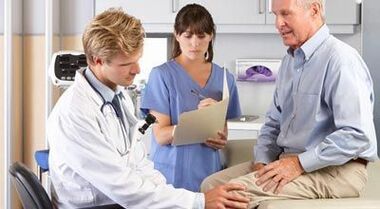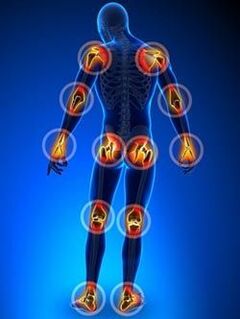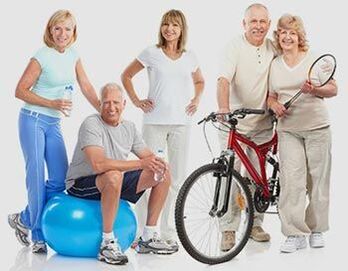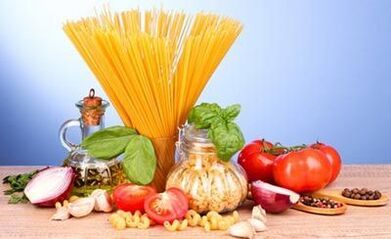The osteoarthritis of the joints is a complex distribution disease that is associated with the destruction of cartilage tissues within the joints.This pathological process is the most common joint disease worldwide.Arthrosis manifests itself by pain, morning rigidity and the limitation of mobility.The gradual progression of symptoms is characteristic, however, the disease development rate may be different.
The diagnosis is performed on the basis of an anamnesis, a clinical examination and radiography results.The treatment of osteoarthritis is usually conservative: exercise therapy, anti -inflammatory medications, physiocence, blocking, etc.
We will consider in more detail what this disease is and how to treat it, we will consider more thoroughly in the article.
What is osteoarthritis?

Arthrosis is degenerative changes in the structure of the joints, which are accompanied by pain and visible deformation.The second name of the disease, which is used in the international classification: osteoarthrosis.
The disease is characterized by slow progression, although it can be accelerated by some external factors.It all depends on the individual characteristics of the body, human disease and its method of vital activity.
According to statistics, osteoarthritis is sick with 6.5-12% of the global population.Most people over 65 (62–85% of cases) suffer.There is a tendency to "rejuvenate" of pathology: in different countries, around 30-35% of patients are people from 45 to 65 years and 2 to 3% of the age of 20 to 45 years.
People who are little familiar with medicine think that arthritis and osteoarthritis are the same.In fact, this is not so, because in the first case the ailment is acute inflammatory, and in the second, a long and less pronounced chronicle.

Guys
The writing of the diagnosis of osteoarthritis may be different, although the essence of the disease is the same.Most of the time, the patient questions and misunderstanding are related to several terminal terms of osteoarthritis:
- Arthrosoarthritis is a classical osteoarthritis, in which an inflammatory process is pronounced;
- Osteoarthrosis is absolutely the same as osteoarthritis;
- Deformation (osteoarthrosis): The late stages found in the disease, which are manifested by deformation and closure of the joint;
- Coksarrosis: an abbreviated term that denotes the injury of the hip joint;
- Gonarrosis is an abbreviated term that means "osteoarthritis of the knee joint";
- Spondilartrosis is the osteoarthritis lesion of the small arten heating joints of the spine.
There are many varieties of this disease.The classification can occur based on the location of the affected areas and depending on the causes of the disease.
Types of osteoarthritis depending on the location:
- Knee
- Hip joints
- Cervical
- Brachial
- Hands and fingers
- Backbone
- Ankle
- Primary potrosoarthrosis
Depending on the number of joints involved, the following varieties are distinguished:
- Monoarthrosis
- Oligoarthrosis: No more than 2 joints are affected.
- Polyarrosis: involved with 3 joint groups.
The degree of damage to the joint
| Degree of osteoarthritis | Symptoms |
| 1 grade | The first stage of osteoarthritis: there are no pronounced morphological changes, only the composition of the synovial fluid is altered.The liquid supplies worse to the cartilaginous tissue with nutrients, the resistance of the cartilage to conventional charges decreases.Due to the overload of the articular surfaces, inflammation occurs, the pain appears. |
| 2 degrees | The articulation is destroyed.They are formed osteophytes.The pain during loads and the movement becomes stronger, a characteristic crunch is heard in the affected places. |
| 3 degrees | This is the most serious development stage of this disease.There is a pathological change in the sites of the painful joints.Inflammation occurs.The patient feels rigidity when moving, since the muscles cannot contract and fulfill their functions. |
Reasons
The formation of osteoarthritis is facilitated by two causes: the load and absence of a complete nutrition that supplies vitamins, minerals for tissue restoration.The joints of each person carry a load.Athletes and dancers, with physical work, the load on their feet is greater, which means that bone joints are wearing faster and require high quality nutrition.With a quiet lifestyle, the support device is slower, but also requires a periodic renewal of fabrics.
Primary osteoarthritis
This type is more frequently associated with innate inferiority and cartilage tendency to damage and destruction as a result of metabolic disorders.The most common causes that cause this disease:
- hereditary and genetic;
- menopause;
- Frequent and, at first glance, minor injuries (for example, among athletes).
Secondary osteoarthritis
The secondary type usually deforms osteoarthritis and progresses at the bottom of a decrease in cartilage stability to the usual load.The development of this pathology is facilitated by:
- wounds;
- obesity;
- Ligament and muscles weakness;
- arthritis.
With age, predisposition to the disease increases.After 70 years, osteoarthritis is diagnosed with every second pensioner.Since the maximum load falls on the feet (a person moves: walks, stops, runs), then it is here where the first signals are formed.
Signs and symptoms of osteoarthritis
Arthosis belongs to the category of chronic diseases.Sometimes, the disease can be filtered imperceptibly for years, only occasionally removing the pain in the joint in the joint or the uncomfortable movement.But it also happens that the disease develops quickly at a serious stage in just a few months.
In any case, it is important to remember, if not the disease is, its symptoms will increase over time, worsen the quality of life and in severe cases, which leads to disability and immobilization.
Symptoms with arthrosis of the joints:
- Pain.Painful sensations are pronounced with osteoarthritis, especially after several types of loads.When a person reaches a state of peace, after a while, awkward sensations disappear.The location of pain occurs directly in the place where there have been changes in the usual structures of the body.In some cases, pain in osteoarthritis can occur when a person rests, being completely relaxed.They appear very abruptly and strongly, which can be compared to dental pain.Very often this happens in the morning.
- The second sign of osteoarthritis is a crunch, but you should not confuse this symptom with the usual joint click, which is found in almost all people, and does not bring discomfort.A crunch in the disease is characterized by a gross and dry sound, brings severe pain and discomfort.With the development of the disease, the symptom is becoming more different and painful.
- Reducing joint mobility.It is also considered one of the characteristic symptoms of osteoarthritis, but it already seems in the stage of active progression of the disease.During the development of osteoarthritis, the growth/germination of bone neoplasms occurs, which leads to muscle tissue spasms, reducing light in the joint bag: the restriction of the movement in this place is guaranteed.
- Joint deformation.Its modification is determined by the fact that osteophytes grow on the surface of the bones and the synovial fluid arrives.Although deformation is one of the last symptoms, when osteoarthritis has hit the joint to a large extent.
- Changes in muscle tone.At first, especially with severe pain, periarticular muscles are reflexively tense.In the future, as motor activity is lost, muscles atrophy.
- Skin manifestations.An optional sign.In the initial stages, skin redness is possible in the projection of the joint.In the future, as osteoarthritis and muscles are progressing, the skin becomes pale, dries, pigmented.
| The joints that osteoarthritis affect more often: | Less commonly suffered: |
|
|
Complications
If osteoarthritis does not provide adequate attention, over time and not to treat correctly, this can lead not only to the complete destruction of the sick joint, but also to a change in the biomechanics of the spine, which makes its hernia on intervertebral discs and the development of osteoarthritis in other joints still healthy.
The danger of an inopportune treatment of any type of osteoarthritis lies in complications related to it, adverse consequences:
- The inflamed joints are deform and gradually destroyed;
- The movements are limited, joint mobility is partial or completely limited;
- The spine is disturbed;
- Hernias Interdiscount are formed;
- Neuralgia develops;
- The standard of the patient with osteoarthritis is reduced;
- The person is disabilities.
Diagnosis
First, they try to see structural changes in the affected areas, to evaluate their severity and prevalence.In addition, metabolic alterations in the body must be determined, which have become a favorable background for the appearance of osteoarthritis.Therefore, the set of surveys consists of the following events:
- Radiography.
- Magnetic resonance tomography.
- Ultrasound study.
- Arthroscopy
- Biochemical blood probas (hormonal spectrum, inflammation markers, calcium metabolism, red).
Taking into account the radiological characteristics, experts in the field of orthopedics and traumatology distinguish the following stages of osteoarthritis (Kellgren-Lawrence classification):
- Stage 1 (doubtful osteoarthritis): suspicion of narrowing of the articular gap, osteophytes are absent or available in a small amount.
- Stage 2 (soft): suspicion of narrowing of the articular gap, the osteophytes are clearly defined.
- Stage 3 (Moderate): A clear narrowing of the articular gap, there are clearly expressed osteophytes, bone deformations are possible.
- Stage 4 (severe osteoarthritis): a pronounced narrowing of the articular gap, large osteophytes, pronounced bone deformations and osteosclerosis.
Keep in mind: the course of the disease in consideration is very slow and in the first stage it can not be characterized by any symptoms, and the pain of inconsistent joints and the increase in fatigue can be inherent even healthy people with great physical effort.Therefore, the independent diagnosis of osteoarthritis is almost impossible.
How to treat articulations osteoarthritis

Outrosis treatment principles:
- eliminate excessive loads in the joints;
- Therapy with anti -inflammatory and analgesic pills.In addition, in complex therapy, condoprotectors are actively used for osteoarthritis;
- Physiotherapy Physical Education;
- sanatorium treatment;
- Magnetotherapy, electrotherapy, laser therapy, shock wave therapy;
- intra -articular oxygen therapy;
- intraóseo block;
- It is important to choose adequate nutrition for osteoarthritis.
Medication methods
How to treat arthrosis with drugs?This problem is the most common among patients.The treatment is carried out using three drug groups:
- Condroprotectors.The drugs of this group restore the hyaline cartilage, since they contain the components that are part of it.All patients recommend them in the form of a long -term document (courses of 3 to 4 months 2 times a year).Use tablets and capsules.
- Hormonal corticosteroids.This drug group is more effective during the exacerbation period of osteoarthritis.Very often intramuscular injections are performed.But a similar category of drugs in pharmacies is also represented in the form of plasters, ointments: they are used only externally, you can expect a fairly fast and powerful effect.
- The use of non -steroid anti -inflammatory drugs to reduce pain and eliminate the inflammatory process.
- InjectionsInjection medications quickly stop pain, reduce active symptoms.Intramuscular, intravenous or intra -articular administration of the medication must be performed only by a medical worker.These funds cannot save the patient from the cause of the development of the disease, but effectively reduce their negative manifestations.
From other medications for the treatment of osteoarthritis, medicines are used:
- Blood improvement in the joints;
- Improvement of the supply of articular tissues of oxygen: vitamins "B";
- acting on metabolism in cartilage;
- Desensitizing agents that reduce body reactivity;
- Synthetic hormones of the adrenal glands.
Surgical treatment
Surgical methods imply two ways to solve the problem:
- Arthroscopy is an operation carried out in a sore joint.Through the puncture, a special needle is introduced, which eliminates damaged areas and polish the affected area.
- Prosthetics is a complex operation, which consists of eliminating damaged joints and incorporating a new one.Modern orthopedics came forward, releasing new improved prostheses that are rarely rejected by the body, and their use does not cause discomfort.
Exercise therapy for osteoarthritis
Medical physical education is used for osteoarthritis in the subacute stage.The main tasks of exercise therapy:
- Orthopedic correction (elimination of defects from the affected limbs);
- decrease in static load in the joints;
- Improvement of articulation mobility or prevention of its deterioration.
I say Gymnastics and a set of exercises for muscles and unearthed joints are carried out.The exercises for the affected joints are carried out in a liar position, on the side or on the back, sitting.They alternate with breathing exercises that help relax the muscles.The patient performs movements in the articulation affected independently or with the help of an instructor.
During classes, the appearance of pain should not be allowed.The exercises are performed at a slow pace and only after eliminating acute symptoms.Sudden amplitude and high amplitude movements should be avoided, which can cause unpleasant sensations.
Physical education must participate in the supervision of a doctor, and after acquiring the necessary skills, you can start home exercises.
Physiotherapy and manual therapy
The use of these treatment methods provides very good results in the initial stages of osteoarthritis.
- The manual treatment must be performed only by an experienced doctor that has been demonstrated in the treatment of joint pathologies.For example, in the treatment of the osteoarthritis of the knee joint, manual therapy together with limb extraction, intra -articular injections and taking condoproprotectors can put the patient on their feet.
- Physiotherapy is used as an auxiliary treatment to accelerate the rehabilitation period.Its main objective is to reduce inflammation and accelerate tissue regeneration.Procedures such as: laser and cryotherapy, heat treatment: ozokerita, mud baths, paraffin and UOF therapy are widely used.
Food and diet

The diet with the osteoarthritis of the joints is aimed at correcting metabolic processes, body weight, prevent irreversible changes in the hyaline cartilage of the joints, a decrease in the inflammatory process and strengthen the structures of the connective tissue joints.There is no special diet with arthrosis of the joints.The following principles are based on therapeutic nutrition:
- Food should be physiologically full and balanced with a high content of vitamins and minerals.The energy value of the diet for patients with normal weight should correspond to the average value of daily energy consumption and not exceed it.
- The use of salt is limited to 5-8 g/day, as well as salty products (salts, canned foods, french fries, salted fish).
- The use of free fluid should be increased to 2-2.5 l/day.
- It is necessary to exclude product processing using fried.The food must bake, steamed, cook or stew.
- It must change to frequent and fractional nutrition.
- Food should be taken in small portions, which will exclude excessively and weight gain.
With osteoarthritis, the use of an extreme hard diet is prohibited.Since in this type of diet, the body expels a large amount of liquid, which, in turn, eliminated calcium and potassium from bones and joints.
Useful products:
- Fish and shellfish, nuts, linen oil, as a source of omega - 3.
- GLAATINE AND GLASA GLAATINE.
- Products rich in vitamin E, D, C, A and Groups B. These are fresh fruits, vegetables and berries.It is especially useful for use: beets, tomatoes, carrots, cabbage, blueberries, legumes, bananas, oranges, apples and whole wheat bread.
- Ginger and other spices.
- Milk and dairy products are an excellent calcium source.
- Newly squeezed useful juices.
Prohibited products:
- Fast food, sausage products, semi -ends products, french fries and all refined products.
- Fat meat.
- Sdoba, white bread, sugar.
- Gordos dairy products, salty cheeses.
- Mayonnaise, transgenic fats.
- White rice, semolina.
- Marinadas, conservation, saling.
- Alcohol, energy, soft drinks.
Popular treatment methods
Before using popular remedies for osteoarthritis, be sure to consult your doctor who attended it.
- Mash the berries of ortiga and juniper in a homogeneous mass.Connect with 1: 3. 3. Toilet to relieve pain, rub the sore joints up to 3 times a day.
- The roots, flowers or branches of a black Saúco.Pour 1 tablespoon.Raw material spoon with 1 glass of boiling water.Insist, wrap, 3 hours, then strain.Drink 1/4 cup up to 4 times a day 30 minutes before meals.
- Boil 10 g of bay leaf in 250 ml of water for five minutes.Leave for five hours.Drink from time to time in small sips all day.Three days we are trying, we rest for five, then we are treated for three days.
- Mustard compress with honey.Mix mustard powder with honey and add an egg.Put the resulting ointment in the gauze and apply to the sore place.
- Complex compress.Cut the cabbage cut into pieces slightly and pass through the polishing.Hume natural wool tissue in juice and join the pain point.
- A series is another excellent remedy for the treatment of osteoarthritis.Boil in 250 ml of boiling water 2 large tablespoons of a series.After 20 minutes, the decoction is ready.Take 2 spoons three times a day before meals.The course is 30 days.
- The chamomile ointment, calendula and burdocita faces pain well, relieves inflammation.For your preparation, you must mix chamomile flowers of equality of quantities, calendula, gross root, connect herbs with oil gelatin and leave for 1-2 days.Use ointment for severe pain up to 5 times a day.
- In boiling water, place the equal parts of the sauce cortex, the boldness and flowers of the calendula.Boil the mixture for 10 minutes, then let it prepare the same amount under the lid.You must take a refrigerated decoction 200 ml half an hour before meals.
Prevention
In a decrease in the risk of osteoarthritis, the following moments play an important role:
- get rid of extra pounds;
- Treatment of musculoskeletal pathologies;
- active movement throughout life;
- adequate nutrition (diet, balanced diet);
- Avoiding joint hypothermia;
- A healthy lifestyle with the correct regime.































